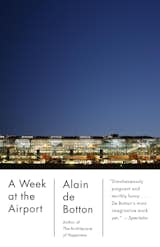A Week at the Airport: Part I
I read half of the slim volume this morning, and right away it's clear that this project suits de Botton's literary gifts. He's a fine describer, one who gets the feeling the details right, even if he does skimp on actual quotes. But the mode in which he really gets humming is not so much journalist as muser. Though his reporting bespeaks a keen eye, his prose rises and falls mostly on his capacity to intuit, interpret, and suppose.
Take this riff on two lovers tearily parting ways outside the security zone of Terminal 5. Our guide is certainly right to call our attention to the unhappy couple as one of many similar scenes played out every day at the airport, but he goes further (maybe too far) when he lets his imagination run a bit more freely than the Sunday Telegraph might permit.
"Passers-by evinced sypathy. It helped that the woman was extraordinarily beautiful. I missed her already. Her beauty would have been an important part of her identity from at least the age of twelve and, in its honour [sic], she would occaisonally pause and briefly consider the effect of her condition on her audence before returning to her lover's chest, damp with her tears."
In another passage he goes a bit off the rails, going into great detail about how the promise of a trip to Greece for a well-to-do British family will inevitably be marred by the standing resentments of their everyday lives. Just how de Botton has managed to penetrate the innerworkings of David and Louise's marriage is unclear. As he provides no actual quotes, nor suggests that he's got any more than a passing understanding of their lives, the reader is left to wonder precisely how he's discerned that David "would be forced to apprehend all of these [the Attic skies, some spanikopita, his children] through the distorting filter of his own being, with its debilitating levels of fear, anxiety and wayward desire." A great vacation to be sure.
He's better when sticking to Heathrow's physical space, of which he "required nothing more extraordinary of the airport than that it continue to operate much as it did every other day of the year...". Or better yet, the haiku-like descriptions of the items on his hotel's room service menu.
My favorite bit comes when he gets to Richard Roger's eye-goggling architecture itself. He lucidly declares that the building's soaring supports "were endowed with a subcategory of beauty we might refer to as elegance, present whenever architecture has the mnodest not to draw attention to the difficulties it has surmounted. On top of their tapered necks, the columns balanced the 400-metre [sic] roof as if they were holding up a canopy made of linen, offering a metaphor for how we too might like to stand in relation to our burdens." Nice stuff.
The book, so far anyway, functions best as an account of a placeless place. What Raymond Carver might have called, where we go when we're going somewhere. For many of us, airports are never fully inhabitated spaces abounding with all our anxieties of going and coming, but with little to distinguish themselves for any other. For those of us without access to first class lounges or other such amenities, the airport is more a class of place, a genre, than an actual locale. Barring the wonderfully light and charming international terminal at SFO in San Francisco, I don't know that I have any real feellings (save vague dread) or even memories about the airport I use all the time.
But by staying put--de Botton even had a desk out in the middle of the terminal which "those who took the trouble to look at my name badge soon came to regard...as a confessional"--the author is afforded the slowness to actually appreciate the place. Quite a good excercise for a design writer, and at least in this incarnation, virgin territory. Or rather, British Airways territory.
I'll finish up the book in the next day or two. Check back later this week for my final report.
Published
Last Updated
Get the Dwell Newsletter
Be the first to see our latest home tours, design news, and more.



